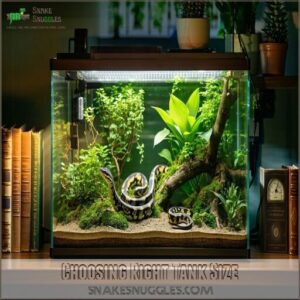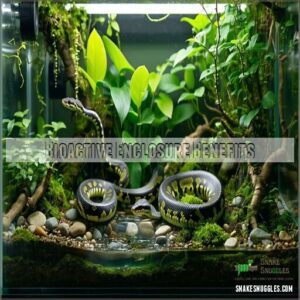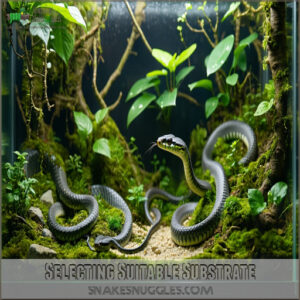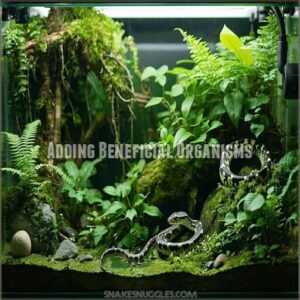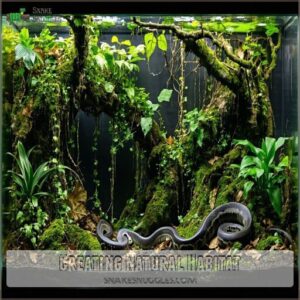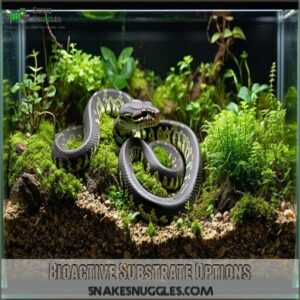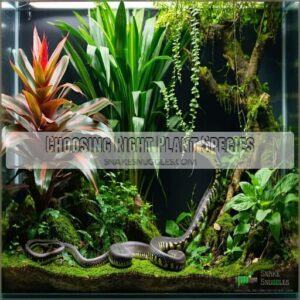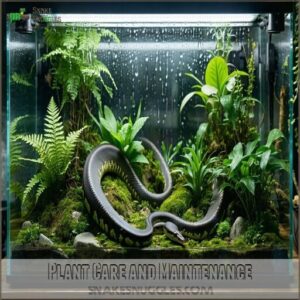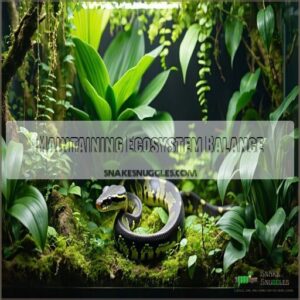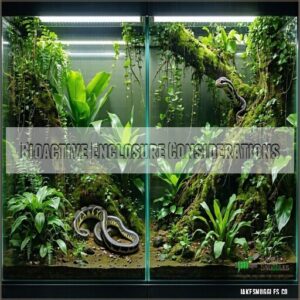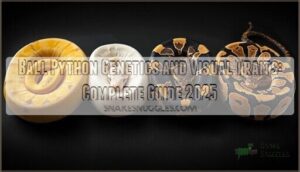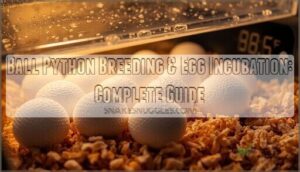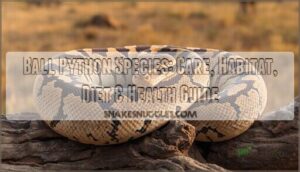This site is supported by our readers. We may earn a commission, at no cost to you, if you purchase through links.
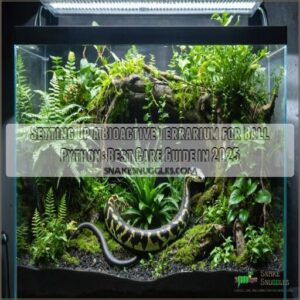
You’ll need the right-sized enclosure (4’x2’x2′ for adults), layered with drainage material and 3-4 inches of substrate like ABG mix or forest floor blend.
Add your cleanup crew – springtails and isopods are nature’s housekeepers – and arrange pesticide-free plants to mimic their natural habitat.
The magic happens when everything works together: your python explores natural behaviors, stress levels drop, and maintenance becomes a breeze.
The key to success lies in selecting the perfect mix of plants that’ll thrive alongside your scaly friend, creating a harmonious and thriving bioactive terrarium.
Table Of Contents
- Key Takeaways
- Choosing Right Tank Size
- Bioactive Enclosure Benefits
- Setting Up Bioactive Tank
- Bioactive Substrate Options
- Adding Live Plants Safely
- Maintaining Ecosystem Balance
- Bioactive Enclosure Considerations
- Frequently Asked Questions (FAQs)
- How to create a bioactive terrarium for a ball python?
- How to set up a bioactive ball python enclosure?
- What is a bioactive vivarium for a ball python?
- What is a bioactive setup for a ball python?
- How do you build a terrarium for a ball python?
- Where should a ball python terrarium be placed?
- How to set up a bioactive enclosure for a ball python?
- Can ball pythons live in a bioactive terrarium?
- Can I put isopods in a ball python enclosure?
- What plants are good for bioactive ball python enclosure?
- Conclusion
Key Takeaways
- You’ll need to choose the right-sized enclosure for your ball python, with a minimum size of 4’x2’x2′ for adults, and layer it with drainage material and 3-4 inches of substrate like ABG mix or forest floor blend.
- To create a thriving bioactive terrarium, you’ll need to add a cleanup crew of springtails and isopods, which will break down waste and promote beneficial bacteria growth, and arrange pesticide-free plants to mimic your python’s natural habitat.
- You’ll want to select plants that are safe for your ball python and can thrive in a humid environment, such as pothos, snake plants, and spider plants, and make sure to avoid plants that are toxic to your pet.
- Regular maintenance is key to keeping your bioactive terrarium healthy, so you’ll need to monitor temperature and humidity levels, check for pests and diseases, and perform regular cleaning and maintenance tasks to ensure your python’s home remains a healthy and thriving environment.
Choosing Right Tank Size
You’ll need a bigger home for your ball python as it grows, starting with a 10-gallon tank for hatchlings.
While glass terrariums are great for maintaining heat and humidity, you can also explore custom wood or PVC options that’ll give your scaly friend plenty of room to thrive, moving up to a 4’L x 2’W x 2’H enclosure for adults.
Adult Ball Python Enclosure Size
For your adult ball python, you’ll need a spacious home to thrive.
Adult males (2-3 feet) and females (3-5 feet) require at least a 4’L x 2’W x 2’H enclosure, though bigger is better.
Your snake’s tank volume should be proportional to its length, and glass terrariums work best for maintaining heat and moisture in your ball python habitat.
Remember, proper space requirements directly impact your snake’s health.
Juvenile Ball Python Enclosure Size
Young pythons need room to grow. Your juvenile ball python will thrive in a 40-gallon terrarium with proper tank dimensions.
- Watch your scaly friend explore every corner of their new kingdom
- Feel pride as you provide the perfect space for healthy development
- Enjoy peace of mind knowing your snake has room to stretch
- Experience the joy of seeing natural behaviors unfold
Remember, appropriate habitat space supports proper growth during this critical stage.
Hatchling Ball Python Enclosure Size
For baby ball pythons, a 10-gallon enclosure provides plenty of space.
Your tiny hatchling will feel secure in this smaller tank, where they can easily find their heat sources and hiding spots.
These little noodles grow quickly though, so plan to upgrade as your snake reaches about 1 foot in length.
Good ventilation and proper enclosure depth matter more than tank length at this early stage, and providing a suitable environment is crucial for the snake’s development and security.
Bioactive Enclosure Benefits
You’ll find that a bioactive setup transforms your ball python’s home into a mini ecosystem, complete with helpful organisms that break down waste and create a more natural environment.
Your snake will show more natural behaviors and experience less stress when living in a habitat that mimics its wild home, with plants and small critters doing the cleaning work for you, creating a more natural environment.
Natural Behavior Stimulation
A bioactive terrarium encourages your ball python’s natural instincts.
In this naturalistic environment, your snake can explore, burrow, and climb just like in the wild.
Environmental cues trigger behavioral patterns, while sensory stimulation keeps their mind active.
You’ll notice more foraging behavior, habitat exploration, and natural movement patterns.
This enrichment creates a meaningful connection between your python and their surroundings, supporting their physical and mental wellbeing.
Reduced Stress for Ball Pythons
The natural environment in a bioactive setup offers your ball python a sense of security that sterile tanks simply can’t match.
Your snake will feel right at home with hiding spots, climbing opportunities, and consistent conditions.
This predictability dramatically reduces stress, improving your pet’s mental health and wellbeing.
Many owners notice their pythons displaying more natural behaviors, less illness, and greater activity when given this enriched, stress-reducing habitat.
Self-Sustaining Ecosystem
A healthy bioactive terrarium works like nature’s recycling system.
Your ball python’s waste gets broken down by tiny helpers like springtails and isopods, creating a self-sustaining ecosystem right in your living room.
This natural nutrient cycling means less cleaning for you and a more stable habitat for your snake.
The organism balance mimics your pet’s wild environment, just without the predators or harsh weather.
By understanding the importance of a bioactive substrate, you can better maintain the delicate balance of your terrarium’s ecosystem and ensure a healthy environment for your pet.
Setting Up Bioactive Tank
You’ll need to layer your drainage, substrate, and living elements to create a thriving mini-ecosystem for your ball python.
Once you’ve set up the foundation, you can add your cleanup crew of springtails and isopods that’ll break down waste and keep your snake’s home naturally clean.
Selecting Suitable Substrate
The foundation of your bioactive terrarium starts with the right substrate. You’ll need something that holds moisture while preventing mold growth.
Here’s what works best for ball python substrate:
- ABG mix (Atlanta Botanical Gardens blend)
- Forest floor substrate (cypress mulch)
- Organic topsoil mixed with play sand (70/30 ratio)
- Coconut coir as a base layer
- Sphagnum moss for humidity pockets
Aim for 3-4 inches of substrate depth to maintain proper humidity levels. When selecting a substrate, consider using a bioactive substrate to create a thriving environment with the right substrate depth.
Adding Beneficial Organisms
The cleanup crew forms the heart of your bioactive terrarium.
You’ll need springtails and isopods, your tiny janitors that break down waste and promote beneficial bacteria growth.
Add these cleanup critters directly onto your substrate, focusing on moist areas where organic matter collects.
Springtails manage fungal growth while isopods process larger debris, creating a balanced soil ecology with minimal effort from you.
Understanding springtail culture is essential for maintaining a healthy terrarium ecosystem.
Creating Natural Habitat
With your beneficial organisms in place, it’s time to create a home that feels like the wild for your ball python.
You’ll want to mimic their natural habitat with loose substrates that maintain humidity. Consider this ball python substrate guide for further details.
Add at least 2-4" of natural soil for them to burrow in. Your snake will thank you by showing natural behaviors!
Remember to remove waste daily and replace substrate every few months in non-bioactive setups.
Bioactive Substrate Options
You’ll want to choose the right mix of substrates for your ball python’s bioactive setup, including organic soil, coconut fiber, and sphagnum moss.
By selecting these natural materials, you’ll create a perfect environment where helpful organisms can break down waste and keep your snake’s home clean and healthy.
Making Bioactive Substrate
You’ll want to start your bioactive substrate mix with a few key layers.
Begin with a drainage layer of clay balls or gravel, then add activated charcoal for filtration.
Top it with a substrate mix of organic soil, coconut fiber, and sphagnum moss. Mix in some leaf litter and springtails to kickstart your microbe balance.
This layered approach guarantees proper humidity control. When creating a bioactive terrarium, understanding ball python substrate options is essential for maintaining the right environment.
Choosing Right Substrate Material
Looking for the perfect substrate mix for your ball python’s bioactive setup? Start with a rich blend of 80% natural soil and 20% play sand as your base.
This organic substrate combo creates an ideal environment for your snake while supporting essential cleanup crews and controlling humidity naturally.
A proper bioactive enclosure setup also includes a drainage layer to prevent the substrate from becoming soggy, and top it off with a generous layer of leaf litter to help maintain those essential moisture levels.
Avoiding Wrong Substrate Types
When selecting substrate for your ball python’s bioactive setup, steer clear of sand, gravel, or wood shavings that pose impaction risks.
You’ll want to avoid substrates prone to mold growth or those that can’t maintain proper humidity levels.
Skip artificial materials and cedar chips, which release toxic oils.
Instead, stick with organic substrate options like coconut husk that support beneficial microorganisms and maintain proper moisture.
Adding Live Plants Safely
You’ll need to choose non-toxic plants that can thrive in your ball python’s humidity and temperature requirements, making sure they’re free of pesticides and properly planted in the substrate.
Your snake will appreciate the natural hideaways and enrichment these plants provide, creating a more realistic habitat that benefits both the ecosystem and your scaly friend.
Choosing Right Plant Species
Within your bioactive terrarium, the right plant species can transform your ball python’s home.
Pothos offers low-maintenance climbing opportunities, while snake plants provide sturdy cover with their upright leaves.
Spider plants create perfect ground coverage, and creeping figs add compact vining interest.
For a splash of color, try bromeliads – they’re safe for your snake and add visual appeal to your terrarium setup, making it a great choice to enhance your ball python’s home.
Plant Care and Maintenance
Now that you’ve picked your snake-safe plants, keeping them happy is pretty simple.
Check soil quality weekly, and water lightly when the top inch feels dry. Trim leggy growth with clean scissors, and skip fertilizers – they might harm your snake.
Your terrarium plants thrive on indirect light and occasional misting.
Plants in a bioactive environment pull double duty: they look great and help maintain humidity naturally.
Maintaining Ecosystem Balance
You’ll need to keep an eye on your ball python’s mini-ecosystem, just like you’d watch over a small garden in your backyard.
Your bioactive terrarium works best when you regularly check temperature, humidity, and cleanup crew activity, making small adjustments before problems start.
Monitoring Temperature and Humidity
With plants established in your bioactive setup, your focus now shifts to maintaining proper conditions.
You’ll need to keep temperature and humidity levels just right for your ball python.
Use a digital thermometer to monitor your temperature gradient (75-80°F cool side, 88-92°F warm side).
Check humidity levels twice daily, aiming for 60-80%.
Mist as needed, but don’t overdo it – finding that sweet spot takes practice, and it’s crucial to maintain the right balance.
Controlling Pests and Diseases
To keep your bioactive terrarium pest-free, quarantine new plants for two weeks before adding them.
Always rinse leaves thoroughly and use clean soil to prevent unwanted hitchhikers.
Cleanup critters like springtails and isopods are your best friends for mite management and fungal issue prevention.
They’ll break down waste naturally, controlling bacterial infections.
Regular plant care includes checking for disease symptoms and balancing your terrarium organisms in the substrate ecosystem.
Cleaning and Maintaining Enclosure
A bioactive setup doesn’t mean zero maintenance. You’ll still need regular checks to keep your ball python’s home in tip-top shape.
- Your heart will skip when you spot your first springtails breaking down waste
- You’ll feel accomplished watching isopods turn droppings into nutrients
- The pride of maintaining perfect humidity without constant misting is unmatched
- That smile when your cleanup crew handles a mess you’d normally scrub
- The relief of knowing your snake explores a naturally clean environment
Simple terrarium maintenance includes:
- Quick temperature checks weekly
- Monthly substrate spot-cleaning where needed
- Removing uneaten food promptly
- Monitoring humidity levels with a digital gauge
- Letting your cleanup crew handle most waste decomposition
Regular reptile care practices are essential for a healthy ecosystem, ensuring your snake’s home remains a healthy environment.
Bioactive Enclosure Considerations
You’ll need to evaluate some important factors before jumping into a bioactive setup for your ball python, like potential pest issues and maintenance challenges.
While bioactive enclosures offer amazing benefits, you’ll want to understand both the drawbacks and solutions to create a safe, thriving environment for your scaly friend.
Potential Drawbacks and Challenges
The reality of bioactive terrariums comes with several challenges that you should consider before diving in.
The challenges can be summarized in the following table:
| Challenge | Impact | Solution | Cost Factor |
|---|---|---|---|
| Initial Costs | High startup investment | Budget planning | $$$$ |
| Maintenance Issues | Time-consuming balancing | Regular monitoring | $$ |
| Humidity Control | Mold and respiratory concerns | Ventilation system | $$$ |
| Escape Risks | Safety hazards | Secure lid designs | $ |
You’ll face temperature gradient challenges too, especially in smaller spaces where maintaining proper heat zones becomes tricky, which can lead to significant maintenance issues.
Overcoming Common Obstacles
Despite the best Obstacle Planning, you’ll face challenges in your bioactive setup.
When Tank Leaks occur, apply aquarium silicone to seal corners. For Snake Stress, create more hiding spots using cork bark.
Combat low Humidity Control by misting daily and covering part of the mesh lid. Guarantee proper ventilation while implementing Escape Prevention through secure lids.
Maintain a temperature gradient by adjusting heating elements, and check your drainage layer regularly to prevent substrate saturation. To achieve desirable results, understanding the importance of a temperature gradient is essential for the well-being of your ball python.
Ensuring Ball Python Health and Safety
With your ball python’s health at stake, routine health checks are essential in bioactive environments.
You’ll need to manage proper waste management, maintain ideal humidity levels (50-60%), and create safe thermal gradients (77-95°F) that mimic natural habitats.
Watch that enrichment items don’t stress your pet, as a healthy ball python in a bioactive setup will display natural behaviors and reduced stress, which are key indicators of a well-managed environment with proper thermal gradients.
Frequently Asked Questions (FAQs)
How to create a bioactive terrarium for a ball python?
You’ll need a drainage layer, substrate mix, springtails, isopods, and live plants. Layer these materials in your terrarium, add cleanup crew organisms, and watch your snake’s natural paradise flourish.
How to set up a bioactive ball python enclosure?
You’ll create a thriving ecosystem by adding substrate, plants, and beneficial organisms to your bioactive enclosure, promoting your ball python’s health and well-being naturally.
What is a bioactive vivarium for a ball python?
You’re making a bioactive vivarium, a living ecosystem in a glass container, mimicking natural habitats for your ball python, promoting health and stimulation.
What is a bioactive setup for a ball python?
You’re diving into a bioactive setup, a mini-ecosystem where beneficial organisms break down waste, promoting your pet’s physical and mental health in a thriving, self-sustaining environment.
How do you build a terrarium for a ball python?
You’ll build a terrarium with a secure lid, heat source, and substrate, considering size and ventilation for your ball python’s comfort and health, using glass for visibility and heat retention.
Where should a ball python terrarium be placed?
Thou seekest wisdom, place your ball python’s terrarium in a quiet, low-traffic area, away from direct sunlight and drafts, you’ll want it to be stable.
How to set up a bioactive enclosure for a ball python?
You’ll create a bioactive enclosure by adding substrate, plants, and beneficial organisms, mimicking your ball python’s natural habitat for reduced stress and improved health.
Can ball pythons live in a bioactive terrarium?
Like a key fitting a lock, ball pythons thrive in bioactive terrariums, which mimic their natural habitat, promoting health and happiness, you can keep them in a bioactive setup.
Can I put isopods in a ball python enclosure?
You can put isopods in a ball python enclosure, they’ll help break down waste, and are a great addition to a bioactive setup, just research their needs first.
What plants are good for bioactive ball python enclosure?
You’re building a mini-ecosystem, and plants like air plants, ferns, and mosses thrive in bioactive enclosures, helping maintain humidity and temperature.
Conclusion
What’s the best way to keep your ball python happy?
You’re setting up a bioactive terrarium for ball python, and it’s a great idea.
You’ll create a mini ecosystem, and with the right plants, substrate, and care, your pet will thrive.
Now, you can enjoy a low-maintenance, self-sustaining environment, and your ball python will love its new home, thanks to your new skills in setting up a bioactive terrarium for ball python.
- https://dubiaroaches.com/blogs/how-to-guides/how-to-set-up-a-ball-python-terrarium
- https://www.zenhabitats.com/blogs/reptile-care-sheets-resources/ball-python-complete-lighting-and-heating-guide
- https://community.morphmarket.com/c/pythons/ball-pythons/5
- https://www.lawinsider.com/dictionary/suitable-habitat
- https://exo-terra.com/explore/academy/bioactive/how-to-set-up-a-bioactive-terrarium/

